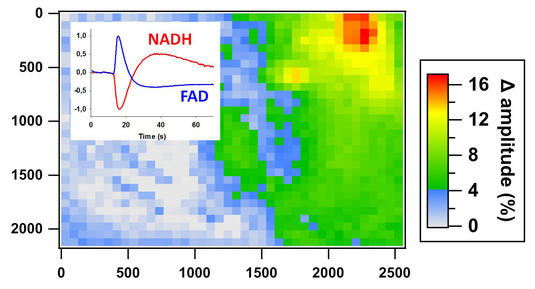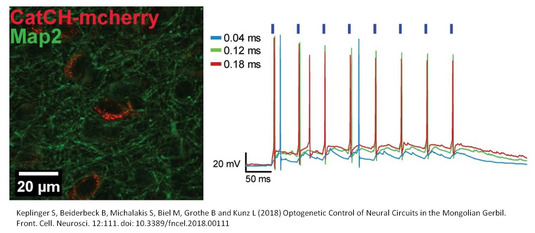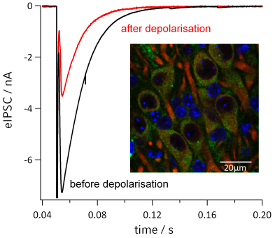Lars Kunz
Metabolic cost of neuronal activity
 Our major research focus is on the correlation of cellular metabolism (energy production and consumption) and electrical activity in neurones. As the function of the brain is associated with high energy and oxygen consumption, we are interested in the metabolic demands of specialised neuronal properties such as high firing rates or temporal precise integration. We are studying these topics by a combined experimental (imaging of NADH, FAD, ATP, O2 glucose) and theoretical approach. In particular, we are trying to answer the question whether neuronal metabolism and its optimisation might impose limitations upon neural circuits. We investigate cellular aspects of this topic in the auditory brainstem of Mongolian gerbils (Meriones unguiculatus), an apt model organism for human hearing, and in semi-intact amphibian brain preparations. In the brain of amphibian tad-poles we can study neuroenergetics in multi-synaptic circuits under in vivo-like conditions.
Our major research focus is on the correlation of cellular metabolism (energy production and consumption) and electrical activity in neurones. As the function of the brain is associated with high energy and oxygen consumption, we are interested in the metabolic demands of specialised neuronal properties such as high firing rates or temporal precise integration. We are studying these topics by a combined experimental (imaging of NADH, FAD, ATP, O2 glucose) and theoretical approach. In particular, we are trying to answer the question whether neuronal metabolism and its optimisation might impose limitations upon neural circuits. We investigate cellular aspects of this topic in the auditory brainstem of Mongolian gerbils (Meriones unguiculatus), an apt model organism for human hearing, and in semi-intact amphibian brain preparations. In the brain of amphibian tad-poles we can study neuroenergetics in multi-synaptic circuits under in vivo-like conditions.
[Trattner et al 2013, PLoS One 8:e67351; Direnberger et al 2015, Eur J Neurosci 41:1332; Brosel et al 2018, Eur J Neurosci 47:222]
Collaborators: Martin Stemmler, Hans Straka (LMU Munich)
Establishing optogenetic & viral tools in the Mongolian gerbil
 To allow studying neurophysiology in auditory brainstem nuclei under optimal conditions, we have developed and established optogenetic tools for the Mongolian gerbil. This powerful technique successfully used in other experimental animals in vitro and in vivo is now also available for gerbils as prime model for auditory research.
To allow studying neurophysiology in auditory brainstem nuclei under optimal conditions, we have developed and established optogenetic tools for the Mongolian gerbil. This powerful technique successfully used in other experimental animals in vitro and in vivo is now also available for gerbils as prime model for auditory research.
[Keplinger et al 2018, Front Cell Neurosci 12:111]
Collaborators: Martin Biel, Stylianos Michalakis, Rainer Uhl (LMU Munich)
The endocannabinoid system in development & modulation of neuronal function
 We are interested in the role of the endocannabinoid system in auditory neurones on different time scales ranging from short term adaptation to functional and morphological development. In auditory brainstem nuclei, retrograde endocannabinoid signalling is involved in activity-dependent regulation of the strength of both excitatory (glutamatergic) and inhibitory (glycinergic) synapses.
We are interested in the role of the endocannabinoid system in auditory neurones on different time scales ranging from short term adaptation to functional and morphological development. In auditory brainstem nuclei, retrograde endocannabinoid signalling is involved in activity-dependent regulation of the strength of both excitatory (glutamatergic) and inhibitory (glycinergic) synapses.
[Trattner et al 2013, J Neurochem 127:78]
Electrophysiological characterisation of astrocytes proliferating in acute brain injury
We are characterising biophysical properties and functionally relevant specialisation of juxtavascular astrocytes. These glial cells have been shown to selectively proliferate in response to acute brain injury.
Collaborators: Magdalena Götz (LMU Munich & HelmholtzZentrum München)
Function of ion channels, neurotransmitters & ROS in the mammalian gonads
The function of ion channels and neurotransmitters in non-excitable cells such as endocrine cells in the human ovary are only scarcely understood, but are of great interest in the context of human fertility and in vitro fertilisation. We are studying the role of these players in the human gonads by a combined experimental and computational modelling approach. In this context we are also interested in reactive oxygen species (ROS) as both noxious and signalling molecules.
[Saller et al 2014, Hum Reprod 29:555; Saller et al 2012, Endocrinology 153:1472; Blohberger et al 2015, Cell Death Dis 6:e1685; Blohberger et al 2016, J Ovarian Res 9:62]
Collaborators: Artur Mayerhofer (LMU Munich)
Methods
- Whole-cell patch-clamp recordings in acute brain slices
- Whole-cell patch-clamp recordings in cultured human ovarian cells
- Live fluorescence imaging of Ca2+, ROS & ATP
- Autofluorescence imaging of metabolic intermediates (NAD, FAD)
- Monitoring of tissue oxygenation
- Immunohistochemistry
- Computational & mathematical modelling of neuronal metabolism

